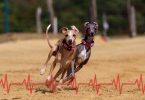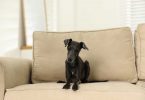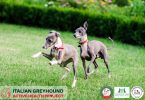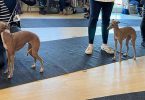If you are here to read The Italian Greyhound Leg Break Recovery Tool Kit, the chances are you and your dog are going through this ordeal right now. Firstly, I would like to say I am so sorry this has happened to you and your dog. I can sympathise, having been through it myself. Secondly, at a time when we are usually full of regret, possibly feeling guilty, and wishing we could turn back time, we need to put that aside for a moment; there is time for that later. Right now you have a journey ahead of you. It will feel like a long one but, in most cases, you will be over the worst of it in a matter of weeks.
In this article, I will draw on my own experiences, and those of other’s I have spoken with, to try to create a one-stop-shop for ideas on how to cope and get through the coming weeks with your canine patient.
The following is intended as inspiration/a general guide only. If the advice from your Vet or Orthopaedic Surgeon is different then it is important that you follow you Vet/Surgeon’s advice to the letter.
Tips for coping with recovery
1. Enlist help with supervising your patient
For a successful recovery, your Italian Greyhound is going to need at least 4-6 weeks monitored rest, factoring in regular toilet breaks. Unless your dog is successfully crate trained, it might be hard for them to adapt to containment, especially for so long, and also if they are a puppy.
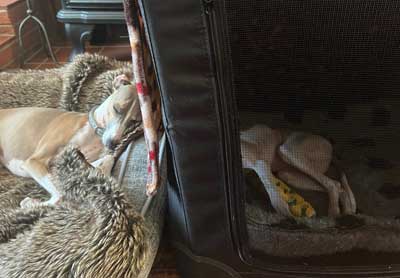
If you have other dogs, it can be especially hard to keep everyone calm and protect the patient. Having someone reliable and conscientious to assist you with baby-sitting duties will be a great relief. Keeping your dog as relaxed and quiet as possible is paramount to their successful recovery.
If developing separation anxiety is a concern, speak to your Vet about when and how to tackle this without jeopardising your dog’s recovery – don’t just wing it. Do enlist the assistance of a professional dog trainer or veterinary behavourist. Check your insurance; you should find it covers the cost of a consultation with a veterinary behavourist, which is likely to be conducted via video call.
2. You will need more than one crate!
Moving your Italian Greyhound from room to room is going to be a must, regardless of how well crate-trained they are! A soft crate can be an asset as they are lightweight for moving from room to room. They are also more forgiving on injured legs when a frustrated patient is making a protest against the crate opening. A downside is that they are not infallible to dogs who are very determined to escape incarceration! If you are able to adequately supervise your patient while in it, this is less of a concern, but it is a consideration to take.
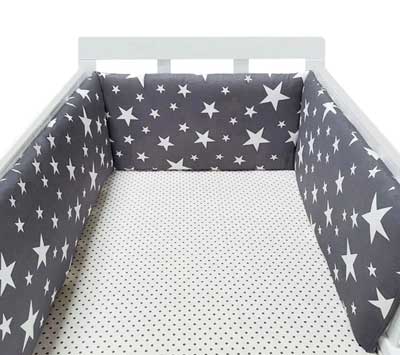
For metal crates, a cot bumper can make the interior of the crate softer to lay against, and stop little legs poking through the bars.
A crate is also a good option for safely travelling your patient in the car, rather than a seat belt on a seat.
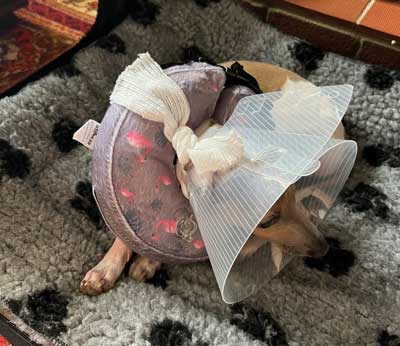
3. Get your own inflatable collar and cone/elizabethan collar (e-collar)
As Italian Greyhounds have such long necks and legs, a standard “cone of shame”/”lamp shade” rarely works effectively. They also look uncomfortable on tiny, fragile, delicate necks. A combination of an inflatable collar beneath a cone helps to prevent insistent interferers; the inflatable collar keeps the cone up around their face, and stops it rubbing the base of their neck.
A soft cone is an option as a deterrent, but might not stop a patient determined to get to their dressing or stitches. Supervision is critical. Find out more in our article 4 alternatives to the Cone of Shame.
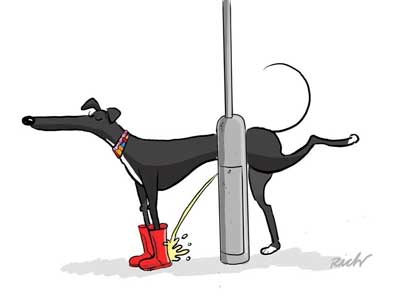
4. Covers for dressings and healing wounds
Particularly in the winter months, you will need some protective covering for their cast, support bandage, or uncovered wounds. This is a necessity if you have a young boy dog! Your Surgeon might discharge your dog with a special boot to pop on their foot for toilet breaks, but if you have a young boy this will simply be a vessel for their urine to land in! You don’t want your boy urinating on his surgery wound, or open fracture site.
I found simple plastic sandwich bags an inexpensive, accessible solution. Other people say a non-lubricated condom works wonders! Alternatively, you can buy or make leg protectors for front legs. Find out more in our article 4 alternatives to the Cone of Shame.
5. Invest in a harness – or two!
During recovery and rehabilitation, it’s perfectly OK for your Italian Greyhound to take some time out of the crate, sat with you on the floor or on the sofa – but you must have a secure hold of him/her, particularly excitable puppies.
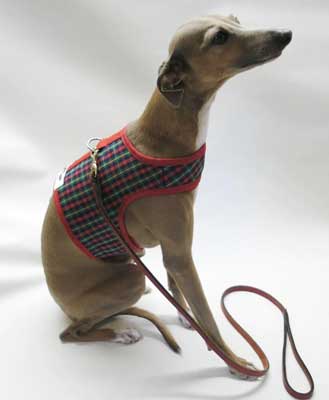
Togs For Dogs by Helen Lister offers a super Comfort Fit Vest Harness. I think this is ideal for quickly transferring your Italian Greyhound in and out of crates, the car, the garden etc. It is like a small vest, secured by super-strong velcro, which offers a wide size range for growing puppies, making the harness a real investment – possibly even into adulthood. You can choose a matching lead for your harness, to complete the set for future when your Iggy is back living his/her life out and about. What I also love about these harnesses is that, if fitted properly, they are pretty much escape-proof. Plus, your Italian Greyhound is unlikely to get a leg caught through any straps, making it ideal for short spells in the crate. One thing it might lack for a convalescing patient is hand straps…
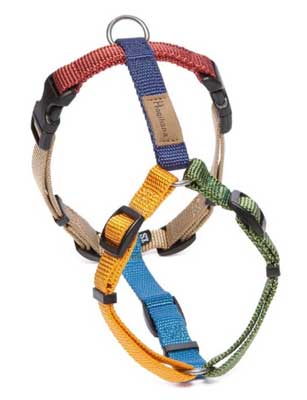
Another great harness is from Haqihana. Again, this is an investment piece. Haqihana is an Italian brand offering a wide range of colours and sizes, again with optional matching leads. They have sizes for “long dogs” (Iggies, Dachshunds etc) – look out for the L in the size options (Italian Greyhound owners need the H harness, NOT the Double-H harness, which is for Whippets). Again, these harnesses have a wide adjustment range, and many Iggies might wear the same size from 3-4 months into adulthood. (These harnesses also have a front chest ring which, later on, is super for training loose-lead walking and tackling pulling.)
A great tip for very wriggly and/or strong patients; putting a strappy harness over a close contact harness can give you an escape-proof option with handles to get a good grip of – handy for check ups at the Vets!
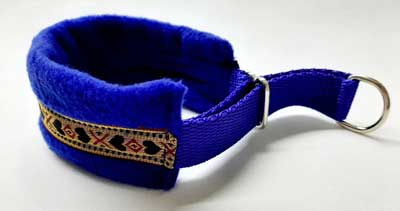
A martingale collar is ideal for middle-of-the-night toilet trips, when you don’t want to have to faff with a harness.
6. You will need plenty of chews!
Chewing is an extremely healthy way for dogs of any age to pass time. It has super benefits when it comes to stress management and promoting calmness.
Study after study have demonstrated that chewing can counter the effects of stress. Not only does it reduce stress hormone levels, it also limits sensory processing of external stressors. In short, it keeps your dog’s attention off things it doesn’t need to be paying attention to.
https://mypetnutritionist.com/post/why-dogs-need-to-chew/
Why Dogs Need To Chew – My Pet Nutriniontist
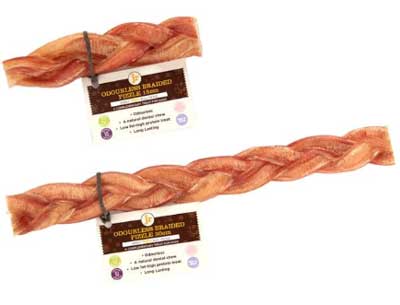
There is now a wide range of natural chews available. JR Pet Products do a very wide range of natural, long-lasting chews, with low-odour options, including odourless pizzels! Pets At Home stock a variety of natural chews, too. Olive/Coffee wood chews are a good hard-to-destruct option, also Yakka’s (Yak milk chews). It’s handy to have a range of chews to keep your patient occupied.
Remember to account for edibles in your patient’s daily food allowance! The lack of physical exercise combined with edible chews to keep them entertained carries an increased risk of weight-gain, which is not ideal when repairing a leg break.
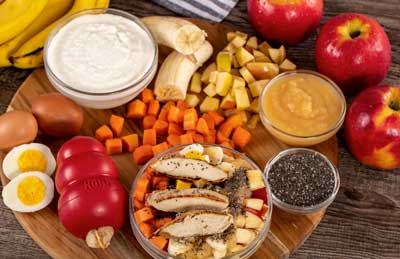
7. Likimats, Kongs and stuffable treats
These are another great way to de-stress and pass time. Kong do their own range of treats and fills for their products, alternatively, you can make your own fillers and spreads!
Again, remember to account for edibles in your patient’s daily food allowance! Consider using part or all of their daily wet food allowance to spread on Likimats and stuff into Kongs. Look for recipes for home made raw spreads and fillers for raw-fed dogs.

8. A Papoose
While life goes on hold for the patient, it certainly has to go on for the rest of the family! Particularly if you have other dogs. A papoose can be ideal for keeping your patient with you when out-and-about. If you can have someone to go with you, it’s ideal for bringing your patient out on a dog-walk.
Obviously, it is imperative that your patient cannot climb, jump, or fall out of it. You will need to prioritise protecting their injured leg from knocks and pushes, above everything else.
However, a carefully planned stroll out with the patient in their papoose, even just 3 times a week, can really break up the weeks of recovery and is good for the mental health of both yourself and your patient. It also means your patient is likely to settle down for a good sleep for a while, giving you a little breather.
Do speak to your veterinary surgeon before deciding on doing this.

9. A Pet Stroller
A pet stroller is another tool to give you and your patient a little more freedom, to break up the weeks of recovery and allow you some normality. The benefit of a pet stroller over a papoose is that your patient will be fully enclosed and less susceptible to knocks and pushes than in the papoose.
Again, it is imperative that your patient cannot climb, jump, or fall out of it, particularly when putting your patient in or take them out of it.
Do speak to your veterinary surgeon before deciding on doing this.
10. A futon or camping mattress on the floor
If you have the capacity to place a futon or standard mattress on the floor, this can be an asset for both day and night.
Night-times can be long and hard with your patient. It is likely to be the longest you will not be able to keep and eye on them. It’s their ideal opportunity to pull at dressings, chew stitches, lick wounds etc. Being able to sleep on the floor next the the crate can be a great relief for both you and your patient.
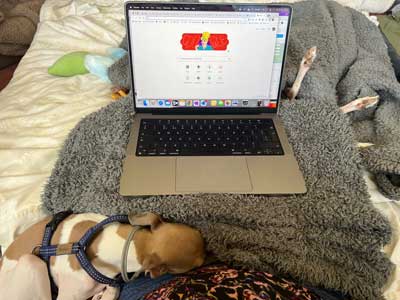
During daytime, the mattress is great for a little entertainment area, where you can have your dog on their harness and leash to safely interact and play with them, without risk of falling off anything or bouncing on the hardness of the floor.
I work from home and could use the mattress to sit on during the day with Pasha on his harness and leash, chewing or sleeping, so he didn’t have to spend hours on end in his crate, or at risk of falling off the sofa.
11. Games
Games with your patient can be great for whiling away the weeks and tiring out brains, especially in puppies. There are games you can use to (safely) incorporate training, too, especially if you have a mattress on the floor as in point 8, for example:
– “Sit”
– “Down”
– “Wait”
– “Find It”
Food puzzles are great, especially if you can use part of their daily food allowance in the puzzle, but obviously greedy dogs can get a little over-exuberant with these things, and healing the injured leg is the no.1 priority.
12. Myotherapy/massage
When my mum’s puppy, Pasha, was recovering I booked him a couple of Myotherapy sessions.
Myotherapy is a complementary therapy using primarily massage techniques to help achieve balance in your dog’s body, assisting chronic musculoskeletal conditions & associated pain, improving health both physically & psychologically.
https://micheletrott.com/canine-myotherapy
CANINE MYOTHERAPY – Michele Trott
Interestingly, my local therapist detected a lot of tension in Pasha’s shoulders, which eased as he gradually became more active. She also showed me some strokes and massage I could do to help ease his tension.
You might find that, as primary care giver, you need a massage to ease tension and trapped nerves. Sleeping on the floor and weeks of carrying your dog around can take it’s toll! After about 4 weeks of carrying Pasha around with me, I couldn’t feel the tips of my fingers on my right hand!
Put your own oxygen mask on first
On that note, if you are the patient’s primary caregiver, especially if you live alone with your dog/s, or spend time alone as the caregiver, do remember to take good care of yourself. If you are well-fed and can get as much sleep as possible, you will cope better.
Follow your Orthopaedic surgeon’s advice – to the letter
Always, always, always follow your veterinary surgeon’s guidance, to the letter
There will always be differing accounts and recommendations for the care and recovery of an Italian Greyhound with a leg break. You are likely to find that people will be quick to tell you that what you are doing is wrong, particularly on social media. Please don’t be tempted to deviate from your veterinarian’s advice – always discuss concerns and questions with them. Every case is different:
- age of the dog
- proximity to growth plates
- location of the fracture
- fragmentation of bone
- displacement of the fracture
- open/closed fracture
There might be other factors your veterinary surgeon is mindful of that you are not aware of. If in doubt, always discuss with them. You are better to seek a second opinion from another specialist Orthopaedic Surgeon than from another dog owner.
Good luck to you and your patient! If you have any questions, please don’t hesitate to contact us. Do share pictures of your Italian Greyhound in The Italian Greyhound Club Facebook Group, and share any tips you have for a successful leg break recovery!
The content provided in this article is for informational purposes only. It is the responsibility of the individual to ensure that the information they are working to is correct and appropriate for their specific circumstances.
© Kelly Wallace Horne, Italian Greyhound Breed Active Health Project 2023. Unauthorised use and/or duplication of this material without express and written permission from this site’s author and/or owner is strictly prohibited. Excerpts and links may be used, provided that full and clear credit is given to Kelly Wallace Horne, The Italian Greyhound Club, and www.italiangreyhoundactivehealth.org.uk with appropriate and specific direction to the original content.





